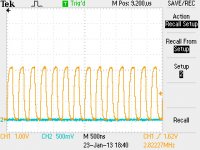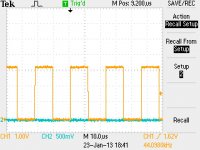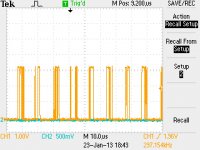I'm almost scared to ask this question, here goes
If SPDIF is normally sent on an 75ohm cable why are we using 50ohm internally.
I realise that it's not just the SPDIF they are being used for.
By the way I'm getting cheaper prices (than Digikey) at Mouser for the Emerson cables & connectors if you buy in US dollars.
If SPDIF is normally sent on an 75ohm cable why are we using 50ohm internally.
I realise that it's not just the SPDIF they are being used for.
By the way I'm getting cheaper prices (than Digikey) at Mouser for the Emerson cables & connectors if you buy in US dollars.
Please show me waveform of all three SCK and WS and SD signals form S/PDIF board I2S output port when you switch to optical input.
Ian
Ian
All three signals, thanks.
Attachments
yeah but you lose the free shipping (for $200 orders) if you do that at mouser, its a case by case basis whether its cheaper overall.I'm almost scared to ask this question, here goes
If SPDIF is normally sent on an 75ohm cable why are we using 50ohm internally.
I realise that it's not just the SPDIF they are being used for.
By the way I'm getting cheaper prices (than Digikey) at Mouser for the Emerson cables & connectors if you buy in US dollars.
where is spdif being used on these cables? i2s is being used on these cables mostly. besides its all about the cable and the termination, not the signal
50 or even 100 ohms is used for both internal and external coax for data or instrumentation cables as well. as long as its consistent, or an appropriate transformer is used to interface 2 different types, its all good.
normally 75ohms is used for external spdif (BNC) use, with 50ohms internally, but with fifo its all i2s carried on 50ohms uBNC
Last edited:
yeah but you lose the free shipping (for $200 orders) if you do that at mouser, its a case by case basis whether its cheaper overall.
where is spdif being used on these cables? i2s is being used on these cables mostly. besides its all about the cable and the termination, not the signal
50 or even 100 ohms is used for both internal and external coax for data or instrumentation cables as well. as long as its consistent, or an appropriate transformer is used to interface 2 different types, its all good.
normally 75ohms is used for external spdif (BNC) use, with 50ohms internally, but with fifo its all i2s carried on 50ohms uBNC
I guess the question is more applicable to me as the new BIIISE I have a a place for a 50ohm connector on the SPDIF input
I didn't realise how small the suckers where until I saw the one that already on the BIIISE Ext MCLK input.
I guess the question is more applicable to me as the new BIIISE I have a a place for a 50ohm connector on the SPDIF input
I didn't realise how small the suckers where until I saw the one that already on the BIIISE Ext MCLK input.
It is still terminated as 75-ohms, however.
I didn't realise how small the suckers where until I saw the one that already on the BIIISE Ext MCLK input.
Yeah they are...I first ran into them when installing a wireless module in a laptop some years back.
they really arent that small or difficult to deal with, guess you havent seen w.fl as used on most of the ackodacs? less than 1/2 the size
good one Brian, they are easier to solder than some other parts these guys are soldering, so once the mental barrier is overcome the body and technique takes over. one thing I would say is dont use the add solder to tip, then touch to connection method, it would be too easy to get a little bit on the rim of the connector. If you do, that can be cleaned off mostly if its on the outside; with some braid and flux, but best avoided as can make the shape and thus impedance of the connection incorrect. It can also damage the cables.
also curved tweezers are recommended
flux is your friend
also curved tweezers are recommended
flux is your friend
It is still terminated as 75-ohms, however.
Is there a mini 75ohm cable/connector you can recommend to take from the to BIII SE SPDIF input to the OTTO & then on to the BNC connector that will be on the rear panel? Or should I just stick with the 50ohm
thanks for the video link
What sort of temperature are you using on the solder iron?
Last edited:
Ian
All three signals, thanks.
Waveform looks perfect. Please measure them on the three diodes at the fifo board to see if signals keep same. Other wise, check up you I2S cable.
Ian
Is there a mini 75ohm cable/connector you can recommend to take from the to BIII SE SPDIF input to the OTTO & then on to the BNC connector that will be on the rear panel? Or should I just stick with the 50ohm
thanks for the video link
What sort of temperature are you using on the solder iron?
I personally just use a piece of regular wire, or a twisted pair from CAT5.
I use Kester 63/37 solder with NoClean flux, 0.15" diameter. (Kester# 24-6337-8806). I generally solder at about 650F. A clean tinned tip is everything.
If you want to use the u.fl connectors, you pretty much have to use 50-ohm u.fl cables, but this should not present any issues with such short distances.
I use Kester 63/37 solder with NoClean flux, 0.15" diameter.
This should be 0.015" diameter. I use this solder for all hand soldering I do.
This should be 0.015" diameter. I use this solder for all hand soldering I do.
Thanks 🙂
Waveform looks perfect. Please measure them on the three diodes at the fifo board to see if signals keep same. Other wise, check up you I2S cable.
Ian
Ian
It should not be the I2S cables as the USB through backdoor works perfect. I bypass the FIFO and connect the SPDIF directly to the BIII, it works with either USB or Optical. It seems that the FIFO does not recognize the signal from optical. Strange!!
Ian
I believe the problem is caused by the dual clock board. It doesn't switch the sf to match the source. It always state at 96!!
Anyway, I will have the i570 to replace it.
I believe the problem is caused by the dual clock board. It doesn't switch the sf to match the source. It always state at 96!!
Anyway, I will have the i570 to replace it.
Ian
I believe the problem is caused by the dual clock board. It doesn't switch the sf to match the source. It always state at 96!!
Anyway, I will have the i570 to replace it.
bigpandahk,
I suspect your isolator board, if there is anything wrong with the control signals, you will lost the Fs auto switching function.
Try removing it, run dual xo from FIFO directly. If it's working then the isolator board is the criminal.
Ian
Thanks Ian
The criminal is the FPC cable from isolator to clock board.
🙂 You won.
- Status
- Not open for further replies.
- Home
- Source & Line
- Digital Line Level
- Build Thread for TPA BIII + Ian Async I2S FIFO + OPC NTD1 + Salas SSLV


